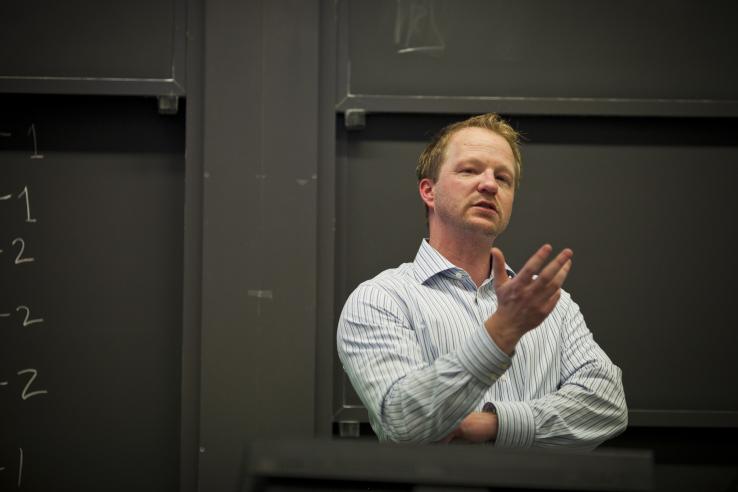
Affiliate Spotlight: Christopher Knittel on researching firm and consumer responses to environment and energy policies

Christopher Knittel is the George P. Shultz Professor and a professor of applied economics at the MIT Sloan School of Management. In this J-PAL affiliate spotlight, Chris sheds light on the research questions he’s pursuing to inform policies on greenhouse gas emissions and carbon co-pollution reductions.
What first drew you to study economics, and why did you choose to focus much of your research around environmental economics and how firms and consumers respond to policies?
I expected to be a lawyer when I entered undergrad, but then I took my first economics class and fell in love with it. I was interested in firm behavior and consumer behavior around firms. My PhD work was in industrial organization. I was doing a lot of work on banking and finance, but when my son was born, I started worrying more about environmental issues. That drew me toward research on local pollution and climate change, and I’ve focused on this ever since.
What research questions are driving your current research agenda?
The overarching question driving my research is how consumers and firms respond to policies and changes in market conditions: whether this is energy prices or policies that impact prices, or policies more generally. I like to come full circle and ask what those responses mean for policy effectiveness and efficiency. I try to understand what firms and consumers do around the energy space and what products lead to pollution, and then write papers to help policymakers design better policies. We’ve focused on energy efficiency because that has been a bipartisan focus for many policymakers. Going forward, I hope that policymakers will enact broader measures around climate change. Much of my work aims to understand climate policies that aren’t on the map today but hopefully will be considered in the future.
What is an example of a randomized evaluation measuring the impact of an environmental or energy policy program that particularly resonated with you? Why did you choose to do this evaluation?
I am wrapping up a study on industrial energy efficiency. Energy efficiency policies have bipartisan support, and a lot of that work focuses on residential consumers—yet questions remain about commercial and industrial facilities and what the impacts of energy efficiency policies might be for them. Catherine Wolfram, Michael Greenstone, and I are finishing an experiment in California that outfitted one hundred industrial facilities with sub-metering. We measured how much energy the compressed air systems were using.
Compressed air might sound boring, but it’s an important consumer of electricity: twenty percent of industrial electricity is used by compressed air. We worked with large firms whose monthly electricity bills were tens of thousands of dollars. To conduct the study, we teamed up with a startup that installs sub-meters and uses data analytics to understand what’s going on. Sometimes, savings were as simple as a notification from the startup saying: “did you know your compressed air machines are running on the weekends, even though you’re not here on the weekends?” Right now, we’re analyzing the data. I don’t want to give away the results, but it’s one of the first experiments that I’m aware of in the industrial space, and we’re excited about this.
What have been some of the most meaningful results or outcomes of your work so far?
Hunt Allcott and I ran a randomized evaluation about how consumers think about fuel costs when buying a car. If you look at the cost-benefit analysis of fuel economy standards, it assumes consumers are myopic (shortsighted), and standards try to correct this. The belief that consumers make mistakes is often conventional wisdom among policymakers. The ideal evaluation to illuminate whether this is accurate would be randomizing loan rates and seeing whether consumers invest more in fuel economy when offered lower interest rate loans. Although we could not do that, we instead asked how consumers respond to information about fuel economy and costs. One reason why consumers might be myopic is if they don’t have such data easily available.
We teamed up with Ford and developed an iPad app about fuel economy and randomly assigned customers walking into seven dealerships across the country to either use the app or see some unrelated information. The app asked what car they drive, what they think gas prices will do in the future, and what car they’re considering. The app took that information and showed them what would happen if they switched to a more fuel efficient car. It translated savings into more tangible terms, such as how many iPads or pairs of jeans they could buy with that money. We then observed what cars those consumers bought.
The results showed that this information does not have an effect on purchases. This is consistent with the idea that consumers were already making accurate assessments of fuel savings, at least on average. We saw both overestimates and underestimates of fuel costs. On average, the information isn’t affecting them, although there is likely to be heterogeneity in these effects (variation in how the treatment affects people), and we were under-powered to test that.
How have your research findings been received and used by the non-academic community?
Questions about how consumers think about fuel economy and the best ways to decarbonize transportation are front and center in the minds of many firms and policymakers. I am fortunate to run a research center at MIT that connects with industrial affiliates and policymakers about research. I’ve heard this study cited in DC and Sacramento and have presented it to policymakers and the Auto Alliance. I think it is one more piece of information for an important policy question.
I think that policy in DC and Sacramento is like a huge boat that takes a long time to turn. The focus on fuel economy standards is going to take a long time to turn towards a focus on something like carbon taxes or alternative policies. I can’t say I’ve seen “the end result” of my work, but I think this work has at least made some policymakers question conventional wisdom, in terms of how consumers make decisions. On the margin, I think my work has helped move them away from what economists have found to be inefficient policies toward more efficient policies.


